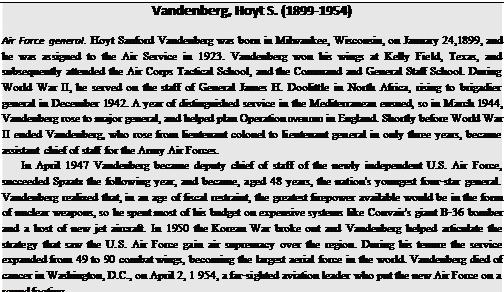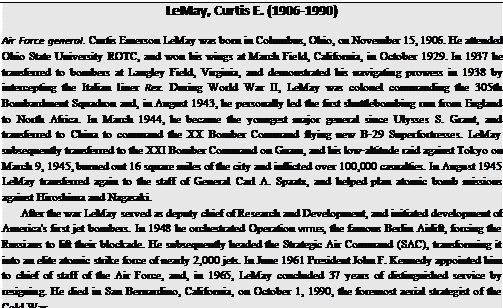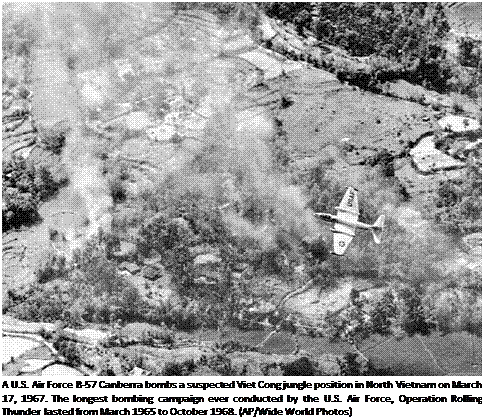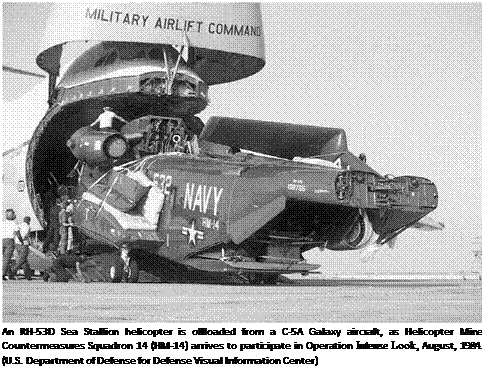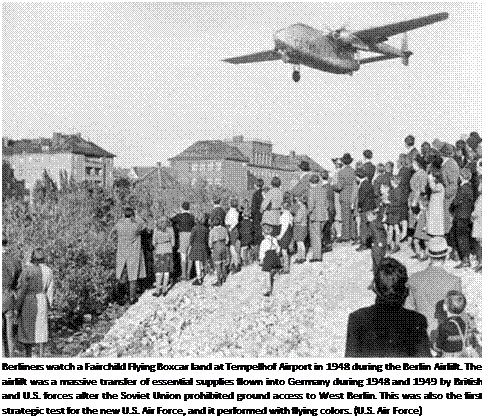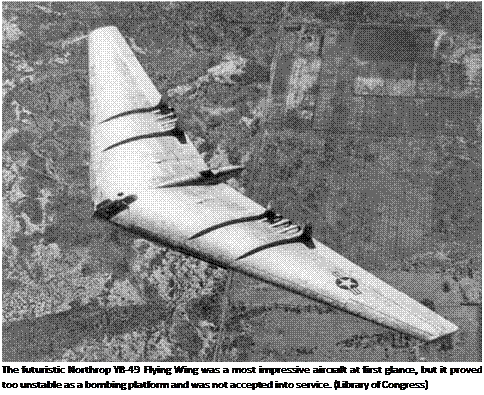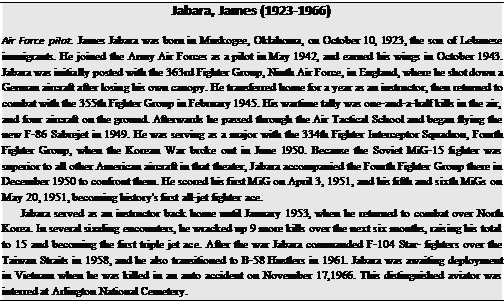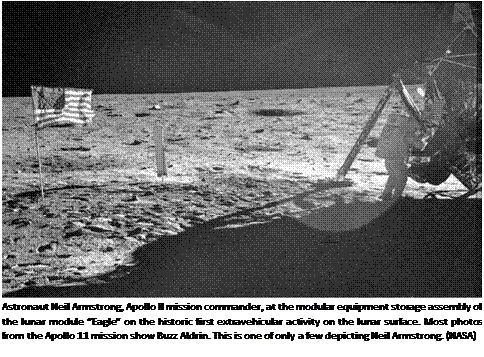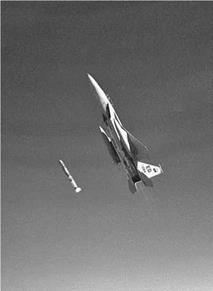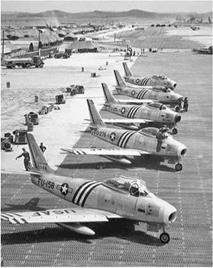January 3-March 15 The Air Force commences Operation hayride after a severe blizzard strikes several Midwestern states. Over 4,700 tons of livestock and supplies are lifted in 200 sorties.
January 5 Over California, a Bell X-1
flown by Major Charles Yeager establishes an unofficial climbing speed record of 13,000 feet per second. This is the only instance of an X-1 taking off under its own power.
January 19 At Holloman Air Force Base, New Mexico, the Martin XB-61 Matador tactical missile is successfully test fired for the first time. This is intended as a short – range, highly mobile tactical weapon.
January 25 The Air Force orders that World War ii-era olive green outfits of Army origin be replaced by slate blue uniforms, although phasing in the new threads will take several months.
FEBRUARY 8 At Andrews Air Force Base, Maryland, a B-47 Stratojet arrives from Moses Lake airfield, Washington, after traveling 2,300 miles in only 3 hours and 45 minutes. This cuts the time of existing transcontinental records in half.
FEBRUARY 9 At Randolph Air Force Base, Texas, the School of Aviation Medicine creates the first Department of Space Medicine.
FEBRUARY 24 At Cape Canaveral, Florida, a two-stage vehicle consisting of a German V-2 and WAC Corporal second stage is launched and reaches 244 miles in height at a speed of 5,150 miles per hour. This launch is part of Project bomber and demonstrates the utility of two-stage projectiles.
February 26-March 2 At Carswell Air Force Base, Texas, the B-50 Lucky Lady II, flown by Captain James Gallagher, arrives after completing a 23,400-mile nonstop flight around the world in 94 hours. The flight requires four in-flight refuelings over the Azores, Arabia, the Philippines, and Hawaii using the probe-and-drogue system developed by the British. The flight also wins the Mackay Trophy.
March 4 In East Germany, the Berlin Airlift (Operation vittles) has delivered over 1 million tons of coal, food, and supplies since the mission began the previous June.
MARCH 15 The Military Air Transport Service (MATS) creates the Global Weather Central to assist the strategic Air Command (SAC) in its mission.
March 26 A B-36D Peacemaker, outfitted with four J-79 jet engines in wingtip pods, flies for the first time. This new configuration can hoist a payload of 85,000 pounds at 440 miles per hour. It also puts the Navy on notice that it does not possess a monopoly on the delivery of nuclear weapons, which increases friction between the two services.
March 30 In Washington, D. C., President Harry S. Truman signs legislation to create the nation’s first chain of permanent defense radar stations.
APRIL 4 In response to increasing Soviet aggression, the North Atlantic Treaty
Organization (NATO) is formed as a defensive alliance. Its creation triggers the rise of the Warsaw Pact behind the Iron Curtain.
April 6 At Tempelhof Airport, West Berlin, Operation vittles achieves its operational highpoint once transport aircraft begin landing every four minutes for six consecutive hours.
APRIL 16 Over Van Nuys, California, the Lockheed YF-94 prototype makes its maiden flight. This is a modified, two – seat version of the F-80 Shooting Star and it enters service as the F-94 Starfire, an all-weather interceptor.
Over Berlin, West Germany, the airlift hits another highpoint once 12,940 tons of supplies arrive through 1,398 aircraft.
May 7 In Washington, D. C., Congress votes to make General Henry H. Arnold a five-star general of the Air Force; he remains the only officer so honored.
May 9 The Republic XF-91 jet/rocket hybrid fighter performs its maiden flight. The craft also features an inverse-taper, variable incidence wing, but it does not enter into production.
May 11 In Washington, D. C., President Harry S. Truman signs legislation to establish a guided missile test range for the Air Force, which eventually emerges as Cape Canaveral, Florida.
May 11-12 In Berlin, East Germany, the Soviet blockade is lifted although Operation vittles continues to stockpile supplies in the city.
May 21 Over Bridgeport, Connecticut, a
Sikorsky S-51-1 helicopter piloted by Captain H. D. Gaddis reaches a world altitude of21,220 feet.
June 4 The Lockheed XF-90 prototype flies for the first time. Envisioned as a strategic fighter that would escort jet bombers to their target, it does not enter production.
July 1 Major General Malcolm C. Grow gains appointment as the first surgeon general of the Air Force and the USAF Medical Service is also established.
The first production F-94A Starfire prototype makes its maiden flight. This is the first Air Force all-weather interceptor equipped with an afterburner.
AUGUST 8 Over California, a Bell X-1 piloted by Major Frank K. Everest reaches an unofficial altitude of 71,092 feet, the highest this generation of research aircraft will reach.
AUGUST 10 In Washington, D. C., President Harry S. Truman amends the National Security Act, which renames the National Military Establishment to the Department of Defense.
August 25 A Bell X-1 flying at 69,000 feet suffers from a potentially disastrous decompression, but pilot Major Frank K. Everest is saved by his T-1 partial pressure suit and he lands his crippled aircraft safely.
SEPTEMBER 24 Over Inglewood, California, the North American T-28 prototype flies for the first time; its enters Air Force and Navy service as the Trojan and serves as an advanced trainer.
September 30 Over West Berlin, East Germany, Operation vittles, the Berlin Airlift, is formally concluded. A combination of Air Force, Navy, and RAF transports lifted 2.34 million tons of supplies into the beleaguered city, which was accomplished in 277,000 flights.
OCTOBER 1 At Cape Canaveral, Florida, Major General W. L. Richardson assumes command of the Long-Range Proving Ground.
OCTOBER 14 The Chase Aircraft Company XC-123 prototype performs its maiden flight; it enters Air Force service as the C-123 Provider, which sees extensive service throughout the vietnam War.
November 19 The Sikorsky YH-19A helicopter performs its maiden flight. This is the first helicopter to have its engine mounted in the nose below the cabin to afford pilots an unrestricted view. It enters service as the Chickasaw.
November 28 At RAF Marham, England, the Douglas C-74 Globemaster I, christened The Champ, arrives from Mobile, Alabama, after a 23-hour nonstop flight. It is also the first aircraft to cross the Atlantic while carrying more than 100 passengers.
November 29 The Douglas YC-124 Globemaster II prototype flies for the first time; this enlarged version of the Globe – master I can carry 50,000 pounds of cargo for 850 miles, and it sees widespread service with the Military Air Transport Service (MATS) and the Strategic Air Command (SAC).
At Desert Center, California, aviatrix Jacqueline Cochran flies an F-51 to a new speed record of 436.995 miles per hour on the Mount Wilson Course.
December 2 At Holloman Air Development Center, New Mexico, the Air Force test fires an Aerobee RTV-A-1a research rocket for the first time.
December 5 In Alaska, the Air Force begins construction of a $50 million network of early warning radar sites to guard
|
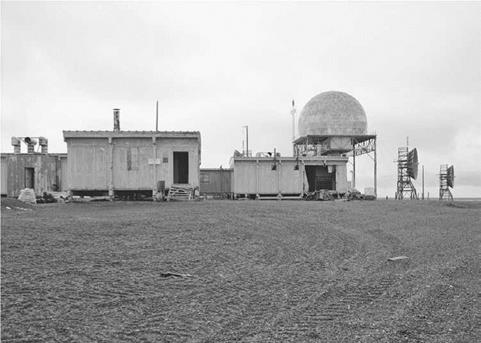
A Distant Early Warning Line Station in Bullen Point, Alaska. Radar of the Distant Early Warning Line across the arctic, coupled with a similar line across the midpoint of Canada allowed for early detection of incoming Soviet bombers across the Arctic Circle. (Library of Congress)
|
|
against incoming Soviet bombers. Each designated station will have a range of 300 miles.
December 22 The North American YF-84D all-weather interceptor performs its maiden flight. It enters service as the F-86D Sabre Dog, an all-weather interceptor with a large radome nose and a retractable rocket tray to shoot down bombers.
December 25 The Air Force unveils the existence of Stupalith, a ceramic product that expands when heated and contracts when cooled and, because it can
withstand temperatures as hot as 2,000 degrees, it will be used as insulation in jet and rocket engines.
December 28 At Wright-Patterson Air Force Base, Ohio, Project saucer disbands after two years, having concluded after two years that flying saucers do not exist.
December 29 At Desert Center, California, aviatrix Jacqueline Cochran pilots a modified F-51 Mustang to an international speed record of 436.995 miles per hour over the 500- kilometer Mount Wilson Course.
JANUARY 15 At Sonoma, California, General of the Air Force Henry H. Arnold dies. One of the architects of
victory in World War II, his career spanned aviation from its infancy to the cusp ofjets and rocket technology.
JANUARY 18 The Lockheed YF-94 Starfire prototype performs its maiden flight. This is the Air Force’s first rocketarmed jet interceptor and enters service in 1953.
JANUARY 23 The Air Force creates its Research and Development Command to separate basic research functions from logistics and procurement activities performed by the Air Materiel Command.
JANUARY 31 In Washington, D. C., President Harry S. Truman, alerted to Soviet endeavors, orders the development of a new and more powerful thermonuclear weapon, the so-called hydrogen bomb.
MARCH 1 In Seattle, Washington, the first production B-47A Stratojet is rolled out and acquired by the Air Force for an engineering inspection before it makes a test hop. This version of the swept – wing, six-jet bomber will be used for training purposes only.
MARCH 15 The government tasks the
Air Force with sole responsibility for developing and deploying strategic guided missiles, or ICBMs, once they become operational at the end of the decade.
MARCH 22 At RAF Marham, England, the Air Force transfers the first of four Boeing B-29s to the Royal Air Force under terms of the Atlantic Pact. It enters British service as the Washington.
April 18 The Air Force declares that it will spend $1.2 billion to acquire 1,250 new aircraft.
April 24 In Washington, D. C., Thomas K. Finletter gains appointment as secretary of the Air Force.
MAY 5 Over Hawthorne, California, the Northrop YRB-49A is flown for the first time. This is a reconnaissance version of the four-jet “flying wing,” with two additional jet engines mounted in pods below the wing. Despite its spectacular appearance, it does not go into production.
May 12 Over California, the Bell X-1 No. 1 research aircraft makes its final flight before being donated to the Smithsonian Institution, where it remains on display to present times.
June 2 At Rapid City Air Force Base, South Dakota, the first operational RB – 36D arrives with the 28th Strategic Reconnaissance Wing. This version mounts four jet engines in addition to six propeller engines.
June 3 The Republic YF-96A jet prototype flies for the first time; this is a swept-wing version of the F-84 and it enters service as the Thunderstreak.
June 23 At Seoul, South Korea, North Korean Yak-9 fighters swoop down upon Kimpo Airfield, damaging a C-54 Sky – master on the ground. This is the first American aircraft lost in the Korean conflict.
June 25 In an act of overt aggression, tanks and infantry from North Korea attack South Korea while Communist airplanes, flown by Russian pilots, attack Kimpo Air Base. In Japan, Major General Earl E. Partridge, commanding the Fifth Air Force, places his organization on alert and increases surveillance activities over the Korean peninsula.
June 26 Over Inchon, South Korea, Air Force F-82 Twin Mustangs fly top cover as vessels begin evacuating American citizens for Japan.
June 27 In Washington, D. C., President Harry S. Truman orders the Air Force to commence combat operations over North and South Korea. Meanwhile, transport aircraft assist evacuations at Seoul, covered by fighters and bombers overhead.
The Air Force scores its first-ever kill as an F-82 piloted by Lieutenants William Hudson and Carl S. Fraser, 339th Fighter All-Weather Squadron, down a Communist Yak-1 fighter near Seoul, South Korea. A total ofseven Communist craft are destroyed, making this the highest- scoring day of 1950.
In Japan, B-26 light bombers begin flying strike missions over South Korea, although poor weather largely negates their efforts. The Fifth Air Force also deploys an advanced echelon at Itazuke Air Base, whereby RF-80s are poised to begin flying reconnaissance missions.
June 28 Over South Korea, B-29 Superfortresses of the Far East Air Forces (FEAF) begin pounding North Korean formations in the vicinity of Seoul. B-26 Invaders of the 3rd Bomb Group also make a successful strike against Communist rail and road traffic near Musan, North Korea, near the 38th Parallel.
The first RF-80A jet reconnaissance mission of the Korean War is executed by Lieutenant Bryce Poe.
June 29 Over North Korea, Japan-based B-26 Invaders drop bombs on the North Korea capital of Pyongyang for the first time in the war. Meanwhile, General Douglas MacArthur instructs Major General George E. Stratemeyer to bomb strategic bridges over the Han River and massed North Korean formations in that vicinity. F-82s defending the airfield at
Suwon also down five North Korean aircraft attempting to attack there.
As eight B-29s finish attacking Communist-held Kimpo Airfield, South Korea, they are attacked by North Korean fighters; one ofthese is downed by a Superfortress gunner. This is the first such aerial victory of the war.
Because military intelligence is sorely needed by United Nations forces, RB-29s based at Yokota Air Base, Japan, begin photo operations over North Korea. They are joined by aircraft of the 8th Tactical Reconnaissance Squadron (TRS) for operations over South Korea.
June 30 In Washington, D. C., President
Harry S. Truman orders full-scale aerial attacks on North Korea, along with a naval blockade of the peninsula and the use of U. S. ground forces to halt the Communist offensive.
In South Korea, the Royal Australian Air Force (RAAF) No. 77 Squadron arrives for duty and is assigned to operational control by the Fifth Air Force.
As North Korean forces swarm southward over the Han River, they are beginning to threaten Suwon airfield, which now houses some of the first tactical Air Control Parties dispatched by the Fifth Air Force. However, Far East Air Forces (FEAF) orders the place to be evacuated to new facilities at Kumhae near the port ofPusan.
July 1 At Itazuke, Japan, transport aircraft of the 374th Troop Carrier Wing (TCW) begin airlifting elements of the 24th Infantry Division to Pusan, South Korea, for the first time.
July 3 In Washington, D. C., Air Force Chief of Staff General Hoyt S. Vanden – berg orders B-29s of the 22nd Bomb Group deployed to Northwest Asia for use in the Korean conflict.
Because large C-54 Skymaster transports are too heavy for most Korean runways and damage them, the Far East Air Forces (FEAF) orders smaller C-46s and C-47s to transport men and supplies there from bases in Japan.
July 6 Over Wonsan and Hungnam, North Korea, nine B-29s conduct the first strategic air raid of the Korean War when they attack oil refineries and chemical plants in the two cities.
Back in the States, the Harmon International Aviation Awards Committee designates James H. “Jimmy” Doolittle as “Aviator of the Decade” while Jacqueline Cochran is named “Outstanding Aviatrix.”
July 8 At Yokota Air Base, Japan, Major General Emmett “Rosie” O’Donnell gains appointment as the head ofBomber
Command (Provisional) within the Far East Air Forces (FEAF). Previously, O’Donnell served as a high-ranking adviser to General Henry H. Arnold during World War II.
July 9 In South Korea, forward air controllers flying L-5G and L-17 Liaison aircraft begin calling in F-80 air strikes to assist hard-pressed UN forces.
July 10 North American T-6 Texan trainers are now used by the Fifth Air Force to call in close support as forward air controllers. These “Mosquito” runs are usually in conjunction with F-80 jets against columns of North Korean forces.
Over Pyongtaek, South Korea, a convoy of Communist vehicles is caught in the open by American B-26s, F-82s, and F-80s after it stops at a bombed-out bridge. The enemy formation is annihilated by
|
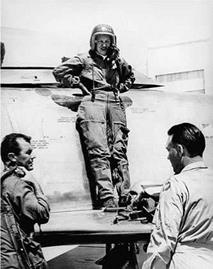
One of the world’s greatest aviators, U. S. pilot Jackie Cochran overcame a hardscrabble existence to set 200flying records, as well as abolishing the gender barrier in her field. Cochran was appointed to lead the Women’s Air Force Service Pilots in 1943. (Library of Congress)
|
bombs and napalm, losing 117 trucks, 38 tanks, and 7 armored cars.
JULY 12 In Japan, four aircraft of the Military Air Transport Service (MATS) arrive from the United States carrying a shipment of 3.5-inch bazookas with shaped charges. These are intended to replace smaller weapons in South Korea that are incapable of destroying Soviet-made T-34 tanks.
At Barksdale Air Force Base, Louisiana, the first RB-50B is delivered to the Strategic Air Command’s (SAC) 91st Strategic Reconnaissance Squadron.
Communist aircraft manage to shoot down a B-29, a B-26, and an L-5, scoring their first aerial victories of the Korean W ar.
July 13 Over Wonsan, North Korea, 49 B-29s from 22nd and 49th Bomb Groups, Far East Air Forces (FEAF), strike an oil refinery and marshalling yards. This is also the first strategic raid launched from bases in Japan, and it is conducted by an RB-29 piloted by Lieutenant Fred Spies.
Off the coast of Korea, an SB-17 of the 3rd Aircraft Rescue Squadron drops rescue boats to members of a downed B-29 crew for the first time.
July 14 In South Korea, the Air Force deploys its first units to operate directly on the peninsula, including the 35th Fighter-Interceptor Group at Pohang and the 6132nd Tactical Air Control Squadron at Taegu. The latter is responsible for orchestrating a close support mission to assist UN ground forces.
July 15 At Taegu, South Korea, the Mustang-equipped 51st Fighter Squadron (Provisional) flies the first F-51 combat missions of the war.
A directive from Fifth Air Force headquarters orders the designation/call sign of “Mosquito” to pertain to all airborne controllers using T-6 Texan aircraft.
July 19 Over Taejon, South Korea, three Communist Yak fighters are downed by F-80s of the Fifth Air Force; this is the highest daily kill rate for the rest of the month.
Over Pyongyang, North Korea, 7 F – 80s of the 8th Fighter-Bomber Group initiate a strategy to acquire complete air superiority by destroying 15 Communist aircraft on the ground.
July 20 In Tokyo, Japan, Major General Otto P. Weyland gains appointment as vice commander of Far East Air Forces (FEAF) for operations.
Over South Korea, two Yak fighters are bagged by Fifth Air Force F-80 Shooting Stars. These are the last American aerial victories until November, when Communist air opposition is dramatically revived.
July 22 In Japan, the carrier USS Boxer arrives carrying 145 Air Force F-51 Mustangs.
At Taegu, South Korea, the first H-5 helicopter to see active service is deployed by the 3rd Air Rescue Squadron.
July 24 At Cape Canaveral, Florida, a German V-2 rocket with a WAC Corporal second stage becomes the first missile launched from the Joint Long Range Proving Grounds.
At Taegu, South Korea, the Fifth Air Force establishes a headquarters near Eighth Army headquarters to facilitate communication and coordination between the two services.
In Tokyo, Japan, General Douglas MacArthur is formally appointed commander of all UN forces and he appoints Major General George E. Stratemeyer, commander of Far East Air Forces (FEAF), to assume responsibility for all air actions over the Korean peninsula.
July 28 In Japan, the first Grumman SA – 16 Albatross arrives for search and rescue missions in the Korean War.
July 30 Over North Korea, 47 Far East Air Forces (FEAF) B-29s attack explosive factories at Hungnam.
AUGUST 1 In Washington, D. C., Generals Joseph Collins and Hoyt S. Vanden- berg conclude an agreement establishing cooperation between the Aerospace Defense Command and the Army AntiAircraft Command for the defense of the United States.
In Florida, Patrick Air Force Base is christened after Major General Mason M. Patrick, the first chief of the U. S. Army Air Service.
Over North Korea, 46 B-29s of the 22nd and 92nd Bomb Groups destroy the Chosen Nitrogen Fertilizer Factory at Hungnam; this is one of the largest chemical plants in Asia.
AUGUST 2—3 At Ashiya, Japan, the 374th Troop Carrier Group establishes a new record by flying 150 tons of equipment and supplies to the Eighth Army in Korea within a 24-hour time period.
AUGUST 3 In Tokyo, Japan, Lieutenant General George E. Stratemeyer, commander of the Far East Air Forces (FEAF) lays down the strategy for Interdiction Campaign No. 1, aimed at cutting enemy supply routes between the 37th and 38th Parallels.
Off the Korean coast, SA-16 Albatrosses begin flying rescue missions to assist downed UN flight crews.
AUGUST 4 Over North Korea, the Far East Air Forces (FEAF) commences Interdiction Campaign No. 1 by dispatching B-29 heavy bombers to destroy key bridges north of the 38th Parallel.
AUGUST 5 At Hamchang, South Korea, Major Louis J. Sebille wins the Air Force’s first posthumous Congressional Medal of Honor by deliberately crashing his F-51 into a North Korean ground position. Because an Air Force medal is not approved until 1960, Sebille receives the Army Medal of Honor.
AUGUST 7 At Yokota Air Base, Japan, the newly arrived 98th Bomb Group commits 20 B-29s to their first air raid over North Korea.
AUGUST 10 In the United States, the Air Force mobilizes two Reserve units, the 437th Troop-Carrier Wing and the 452nd Bomb Wing, for active duty; these are the first of 25 such units called into service for the Korean War.
AUGUST 11 The Fairchild XC-120 performs its maiden flight; this novel craft is assembled from wings and tail sections of the C-119B Flying Boxcar, but it does not enter production.
At Tachikawa Air Base, Japan, Air Force C-119 Flying Boxcars airlift trucks and other heavy equipment directly into Taegu, South Korea.
AUGUST 16 A force of nearly 100 B-29s drops bombs on massed North Korean troops at Waegwan, South Korea, in a spoiling attack to prevent them from overrunning the Pusan Perimeter. This is the largest carpet bombing raid ofits kind since Operation COBRA at Normandy in August 1944.
AUGUST 19 In South Korea, Air Force and Navy aircraft help blunt a North Korean drive across the Naktong River, allowing the Battle of Naktong to end in a UN victory.
AUGUST 22 Over North Korea, Chinese antiaircraft batteries open fire on B-29 formations from across the Yalu River in Manchuria. This is the first recorded hostility of Chinese Communists in the Korean War.
AUGUST 23 West of Pyongyang, North Korea, the Air Force makes its first Razon guided-bomb strike of the war, although only one weapon strikes its intended target.
AUGUST 25 In Tokyo, the Fifth Air Force is ordered to maintain constant armed surveillance of enemy airfields in North Korea to prevent enemy aerial activity during the upcoming Inchon landings.
AUGUST 26 In Washington, D. C., Air Force Chief of Staff Hoyt S. Vandenburg presents the Bell X-1 No. 1, the vehicle that broke the sound barrier, to the Smithsonian Institution.
At Barksdale, Louisiana, the 91st Strategic Reconnaissance Wing receives its first operational RB-45C Tornado.
At Ashiya, Japan, General William H. Tunner, who had previously directed the Berlin Airlift, organizes the new Combat Cargo Command (Provisional), which is built around the 1st Troop Carrier Task Force (Provisional). Meanwhile, orders go out from the Far East Air Forces to collect all C-46 transport aircraft in Asia to support a major UN offensive the following month.
AUGUST 27 Over Antung, China, two F-51 Mustangs accidentally cross the border and strafe a Chinese airstrip, thinking that they were attacking a North Korean field near Sinuiju. The Chinese government uses the affair for propaganda and diplomatic purposes.
AUGUST 31 Outside Pusan, South Korea, North Korean forces make a last-ditch effort to drive UN forces back into the sea, but they are partly thwarted by close air support missions flown by the Navy and Fifth Air Force.
Over North Korea, a force of 74 B-29s attack mining facilities and marshalling yards at Chinnampo. This is also the largest strategic bombing raid of the entire month.
September 1 At Biggs Air Force Base, Texas, the first operational KP-29P tanker deploys with the 97th Air Refueling Squadron. This variant is the first American tanker craft equipped with an aerial boom, which replaces the British-style trailing hose equipment used on the KB-29M.
Outside ofPusan, South Korea, Fifth Air Force fighter-bombers and light bombers continue working over Communist armor and infantry formations with machine guns, rockets, and napalm to support the UN perimeter.
SEPTEMBER 4 Over South Korea, a Sikorsky H-5 helicopter piloted by Lieutenant Paul W. Van Boven performs the first rescue mission of a pilot, Captain Robert E. Wayne, then downed behind enemy lines.
September 9 In order to retard the possible arrival of Communist reinforcements to the Inchon landing site, Far East Air Forces (FEAF) Bomber Command begins a rail interdiction effort north of Seoul, South Korea. Heavy and medium bombers begin hammering key marshalling yards and resupply points over the next week.
SEPTEMBER 15 At Inchon, South Korea, UN forces under General Douglas MacArthur stage a brilliant surprise landing behind enemy lines while medium bombers and fighters of the Far East Air Forces (FEAF) strike at targets near Pusan to assist the forthcoming breakout.
September 15—18 At Bergstrom Air Force Base, Texas, 180 F-84Es of the 27th Escort Fighter Wing begin flying in relays to airfields in West Germany. The next wave completes the move on October 15-28.
September 16 The USAF Research and Development Command is redesignated the Air Research and Development Center (ARDC).
At Pusan, South Korea, the Eighth Army breaks through encircling North Korean unit and moves up the peninsula, closely supported by Fifth Air Force fighters and bombers. Communist forces retreat helter-skelter to avoid being cut off.
SEPTEMBER 17 Near the Naktong River, South Korea, Fifth Air Force F-51s and
F-80s drop napalm on retreating North Korean columns, killing hundreds of enemy troops.
Over North Korea, the Far East Air Forces begins a psychological campaign by dropping four million leaflets over the battered inhabitants.
September 18 For a second time, 42 B-29s from the 92nd and 98th Bombardment Groups, Far East Air Forces (FEAF), carpet bomb North Korean troop concentrations in and around Waegwan, removing a major obstacle to the Eighth Army’s surging offensive.
The third anniversary of the U. S. Air Force as an independent service finds it deeply immersed in the first armed conflict of the Cold War.
September 19—20 Over South Korea, the Combat Cargo Command begins airlifting men and supplies to Kimpo Air Base, Seoul, with a force of 32 C-54 Sky – masters. These operations are flown around the clock to supply the surging UN offensive underway.
September 21 Outside Pusan, South Korea, Air Force T-6 Mosquitos observe a column of 30 North Korean tanks advancing upon the U. S. 24th Infantry Division, and direct the requisite air strikes to thwart them; 14 tanks are destroyed and the rest flee in confusion.
SEPTEMBER 22 Operation Fox Able Four unfolds as Colonel David Schilling flies the first nonstop transit over the Atlantic Ocean by touching down safely at RAF Manston in Kent, England. The flight from Limestone, Maine took 10 hours, covered 3,000 miles, and required three in-flight refuelings. However, wingman Lieutenant Colonel William D. Ritchie ran out of fuel over Labrador and ejected; Schilling wins the Mackay Trophy for his efforts.
|
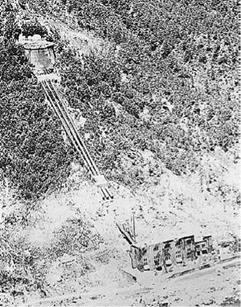
This reconnaissance photograph taken in 1952 depicts a power plant made unserviceable by United Nations Command (UNC) warplane attacks. The campaign against North Korean hydroelectric plants in the summer of 1952 was launched by the Far East Air Force in the hope of forcing the Communists to accept UNC truce terms. (National Archives)
|
Over Kunsan, South Korea, a T-6 Mosquito flown by Lieutenant George W. Nelson drops leaflets to a body of North Korean troops, urging that they surrender or face annihilation. The Communists comply by moving to a designated position, where they surrender to UN forces.
September 23 At Pusan, South Korea, the headquarters of the Fifth Air Force packs up and relocates to Taegu to be closer to the front.
An SB-17 from the 3rd Air Rescue Squadron makes the first recorded classified flight during the Korean War.
September 26 Fifth Air Force fighters and bombers continue supporting the UN drive northward towards the 38th Parallel as they unite at Osan.
Over Haeju, North Korea, a force of 20 B-29s from the 22nd Bomb Group attack and destroy a munitions factory and a power plant. A hydroelectric plant at Pujon is also bombed by another group of B-29s. These raids conclude the Far East Air Forces’ (FEAF) first strategic bombing campaign.
September 27 In Washington, D. C., the Joint Chiefs of Staff (JCS) decides to halt further strategic raids against North Korea for want of suitable targets.
SEPTEMBER 28 Over Holloman Air Force Base, New Mexico, a research balloon carries eight white mice to an altitude of 97,000 feet, then returns them unharmed.
At Yokota Air Base, Japan, the first three RB-45C Tornado reconnaissance jets arrive for duty with Far East Air Forces (FEAF). Officially, they are known simply as Detachment A, 84th Bomb Squadron.
September 29 Over Holloman Air Force Base, New Mexico, Captain Richard V. Wheeler performs a record parachute jump from 42,449 feet and lands unscathed.
OCTOBER 2 Over Nanam, North Korea, Far East Air Forces (FEAF) B-29s carpet bomb North Korean troop training facilities to retard enemy attempts at reinforcements.
At Taegu, South Korea, the 8th Tactical Reconnaissance Squadron (TRS) is the first such unit deployed at K-2 airfield.
OCTOBER 6 As of this date, headquarters Far East Air Forces (FEAF) assumes control of all UN land-based aircraft, including several U. S. Marine Corps squadrons flying out of Kimpo.
In South Korea, No. 2 Squadron, South African Air Force deploys under the aegis of the Far East Air Forces (FEAF).
Outside of Seoul, South Korea, the Marine Corps relinquishes control of Kimpo Airfield, which was captured earlier in September.
Over Kan-Ni, North Korea, 18 Far East Air Forces (FEAF) B-29s attack a Communist arsenal while FEAF headquarters also orders attacks against bridges south of Pyongyang and Wonsan halted.
OCTOBER 8 The Air Force receives a new shipment of modified and more reliable Razon radio-controlled guided bombs, and bombing missions with them resume.
Over North Korea, two F-80 Shooting Stars accidentally cross the border and strafe a Soviet airfield near Vladivostok. An enraged Air Force Chief of Staff Hoyt S. Vandenberg orders the two pilots court – martialed and the group commander relieved.
October 10 In the United States, the first Air National Guard units are mobilized for service in Korea. Ultimately, 66 such units, representing 45,000 personnel, will be deployed there.
In Europe, Lieutenant General Lauris Norstad gains appointment as commander of United States Air Force in Europe (USAFE).
OCTOBER 15 At Davis-Monthan Air Force Base, Arizona, the Air Force commences the B-47 phase-out program by retiring the first of its RB-47Es.
OCTOBER 20 Over Pyongyang, North Korea, over 100 C-47 and C-119s transport aircraft convey 4,000 Army paratroopers and their supplies on a battlefield drop 30 miles north of the Communist capital.
OCTOBER 25 In Tokyo, Japan, headquarters Far East Air Forces (FEAF), halts all B-29 air raids due to a lack of strategic targets in North Korea. However, all restrictions are lifted on medium bombers and fighters so that they can provide close support missions up to the Manchurian border.
Over Korea, the Combat Cargo Command establishes a new daily record of 1,767 tons lifted and delivered.
In an ominous development, Communist China decides to enter the Korean War and begins infiltrating thousands of troops across the Yalu River.
OCTOBER 26 Over North Korea, C-119s of the Combat Cargo Command deliver 28 tons of ammunition and supplies to troops isolated on the battlefield.
OCTOBER 28 In Europe, F-84s of the 27th Fighter Escort Wing finish deploying from the United States. This first-ever mass transfer ofjet aircraft across the Atlantic wins the Mackay Trophy.
NOVEMBER 2 At Yokota Air Base, Japan, the first RB-45C reconnaissance mission is flown over North Korea.
NOVEMBER 4 Over Chongju, North Korea, Fifth Air Force B-26s provide close air support to Eighth Army troops, killing hundreds of Communist soldiers.
NOVEMBER 5 Over Kanggye, North Korea, 21 B-29s from the 19th Bomb Group drop 170 tons of incendiaries and destroy 65 percent of the central sector. This target is only 20 miles south of the Manchurian border and marks the beginning of a new strategy by Bomber Command.
NOVEMBER 8 Over Sinuiju, North Korea, the largest incendiary raid of the Korean War unfolds as 70 B-29s drop 580 tons of fire ordnance directly next to the Chinese border. Various bridges along the Yalu River are also bombed for the first time.
Near the Manchurian border, Soviet – piloted MiG-15 jets, sporting North Korean markings, engage a flight of Air Force F-80 Shooting Stars for the first time. Lieutenant Russell J. Brown is credited with downing the first Communist jet in combat, although postwar records suggest that the MiG, while damaged, managed to return to base.
NOVEMBER 9 Over North Korea, B-29 tail gunner Airman Harry J. LaVerne shoots down the first MiG lost to a heavy bomber. However, LaVerne’s own aircraft is heavily damaged in the exchange and it crashes in Japan, killing five crewmen.
November 10 The effectiveness of the MiG-15’s bomber-killing cannon armament is underscored this day when a B-29 of the 307th Bombardment Group is brought down near the Yalu River. The crew manages to parachute to safety and spends the rest ofthe war as prisoners.
November 18 Jets of the 35th Fighter Interceptor Group (FIG) transfer from their base in South Korea to Yonpo airfield outside Hungnam, North Korea. This enables them to fly and fight much closer to the front lines.
NOVEMBER 19 Over Musan, North Korea, 50 B-26 Invaders stage the first – ever mass light bomber attack when they dump incendiaries and destroy most of the town’s barracks complex.
NOVEMBER 23 Over North Korea, Far East Air Forces (FEAF) B-29s hammer Communist communications, bridges, and supply centers while Fifth Air Force fighters and medium bombers provide close support missions for UN troops. Transports of the Combat Cargo
Command also redouble their efforts as General Douglas MacArthur begins his final drive to the Yalu River.
NOVEMBER 25 In North Korea, Chinese Communist forces launch a massive counteroffensive that begins pushing UN forces back down the peninsula.
In Japan, a C-47 detachment from the Royal Hellenic Air Force arrives for duty and is subordinated to the Far East Air Forces (FEAF).
NOVEMBER 26 Over North Korea, as mass Chinese forces bear down on the Eighth Army and the X Corps, B-26 Invaders begin flying their first close air support missions at night.
NOVEMBER 28 Over North Korea, radar-equipped B-26 Invaders begin safely dropping bombs within 1,000 yards of UN lines for the first time.
Transports of the Combat Cargo Command begin evacuating hundreds of wounded and frostbitten marines from the Chosin region of North Korea while also dropping 1,600 tons of equipment and supplies to the front lines.
December 4 Over Sinuiju, North Korea, the world’s first jet bomber interception unfolds as a flight of Soviet-piloted MiG-15s down an RB-45C Tornado on a reconnaissance mission.
December 5 This day C-47s of the Royal Hellenic Air Force begin flying with the Combat Cargo Command to supply UN forces in northeastern North Korea; most missions start and begin at a frozen airstrip at Hagaru-ri.
December 6 At Itazuke, Japan, F-84s of the 27th Fighter Escort Wing begin flying close ground support missions to North Korea and back.
December 7 Over North Korea, B-29s of the Far East Air Forces (FEAF) pound Communist troop concentrations near the Changjin Reservoir as marines and army troops prepare to break out of an encirclement. Crude airstrips are continually being built as they retreat to accommodate transports of the Combat Cargo Command.
Near the Chosin Reservoir, North Korea, eight C-119 Flying Boxcars parachute several bridge spans to U. S. forces so that they can cross a 1,500-foot-deep gorge. This is also the first time that a complete bridge has been airdropped.
DECEMBER 14 Over Huichon, North Korea, Air Force planes drop the first six-ton Tarzon bomb near a railroad tunnel. Like its predecessor, the Razon, this device fails to live up to expectations.
December 14—17 Near Hamhung, North Korea, transports of Combat Cargo Command begin a three-day aerial evacuation, lifting 228 patients, 3,891 passengers, and 20,088 tons of cargo to safety as Chinese forces begin closing in on the airfield.
December 15 In response to the MiG – 15’s appearance over North Korea, the 4th Fighter Interceptor Group (FIG) deploys the F-86 Sabrejets to Japan as a counter. The stage is now set for a classical aerial encounter.
B-29s of Bomber Command begin a new series of zone interdiction raids to stop surging Chinese forces in North Korea.
DECEMBER 17 Over North Korea, the F- 86 Sabrejet draws first blood when
Lieutenant Colonel Bruce H. Hinton shoots down a MiG-15. This is the first aerial victory between swept-wing jets in aviation history.
December 20 At Kimpo, South Korea, Operation kidlift commences as 12 C – 54s of the 61st Troop Carrier Group begin lifting Korean orphans to an island offthe coast of Pusan.
December 22 Over North Korea, six Russian-piloted MiG-15s fall to the guns of one Navy and five Air Force jet fighters; this is also the highest daily victory toll for a single day since June. However, one F-86 is also shot down for the first time.
At Seoul, South Korea, headquarters, Fifth Air Force, relocates back to Taegu as Chinese forces advance upon the city from the north.
December 23 In a daring move, 3 H-5 helicopters evacuate 11 U. S. and 24 South Korean soldiers trapped eight miles behind enemy lines.
December 24 At Hungnam, North Korea, the last of 105,000 troops belonging to X Corps, along with 91,000 civilians, are evacuated as B-26s bombers and Navy gunfire pin down advancing Chinese forces.
December 29 From Taegu, South Korea, the first RF-51 reconnaissance missions are staged. Though slower than RF-80s, the Mustangs have greater range and endurance in the air.
JANUARY 1 The Air Defense Command (ADC), having been previously abolished,
is restored under General Ennis C. Whitehead.
In South Korea, as half a million massed Chinese and North Korean forces pour over the 38th Parallel, they are heavily racked by fighters and bombers of the Fifth Air Force.
JANUARY 2 Over South Korea, flares dropped by a C-27 transport illuminate target areas for B-26 and F-82 night attacks on Communist troop concentrations and supply lines.
JANUARY 3—5 Pyongyang, North Korea, is staggered by 60 Bomber Command B – 29s which drop 650 tons of incendiaries on the city; a follow-up raid is launched two days later. This day Far East Air Forces (FEAF) also achieve a one-day record by mounting 958 combat sorties.
JANUARY 4 Near Seoul, South Korea, the last remaining Air Force planes evacuate Kimpo Airfield for the second time in six months as Chinese forces approach the city. The landing strip is then heavily bombed to preclude any possible use by the enemy.
JANUARY 6 Over South Korea, transports of the Combat Cargo Command finish resupplying the U. S. 2nd Infantry Division as it fights to prevent a Chinese breakthrough in UN lines.
JANUARY 10 In Tokyo, Japan, Brigadier General James E. Briggs gains appointment as the new head of Bomber Command. The Strategic Air Command (SAC) has mandated that new commanders will be rotated every four months to grant wartime experience to as many senior leaders as possible.
JANUARY 12 Over South Korea, Far East Air Forces B-29s attack massed Communist troops with 500-pound bombs fuzed for aboveground airbursts, and the ensuing shower ofsteel fragments staggers their formations.
JANUARY 13 Over Kanggye, North Korea, a Far East Air Forces B-29 drops a six-ton Tarzon bomb on an enemy bridge, scoring a direct hit and destroying 60 feet of the structure.
JANUARY 16 At RAF Lakenheath, England, six B-36 Peacekeepers complete a nonstop 7,000-mile deployment from Bergstrom Air Force Base, Texas.
Project MS-1593 is initiated by the Air Force and Convair to acquire a viable intercontinental ballistic weapon; in time it emerges as the Atlas missile.
January 17 At Taegu, South Korea, F-86 Sabres are redeployed on the peninsula, only this time as fighter-bombers for close support missions.
JANUARY 17—18 Over South Korea, Combat Cargo Command launches 109 C-119 missions, which drop 550 tons of supplies and ammunition to UN forces on the front lines.
JANUARY 19 Because the Communist forces have greatly overextended their supply lines in their drive south, Far East Air Forces (FEAF) commences an extensive aerial interdiction campaign to deny them badly needed supplies and reinforcements.
JANUARY 21 Over North Korea, a big dogfight results in the loss of one F-86 and one F-84 to MiG-15s. However, Lieutenant Colonel William E. Bertram scores the first MiG-15 kill by an F-84.
JANUARY 23 Over Sinuiju, North Korea, an attack by 33 F-84s stirs a large number of MiG-15s from across the Yalu River, resulting in a 30-minute dogfight. This time, the Thunderjets get the better of it, downing three MIGs.
A combined force of 21 B-29s and 46 F-80s attack antiaircraft emplacements and airfields, heavily damaging both.
January 25-February 9 In South Korea, Operation thunderbolt unfolds as UN forces counterattack in an attempt to recapture Inchon and the Suwon airfield. They are assisted by 70 C-119s of Combat Cargo Command, which deliver 1,162 tons of supplies as they advance.
January 26 Over South Korea, a C-47 heavily rigged with radios can maintain contact with all T-6 Mosquito aircraft and coordinate their efforts. This is an early attempt to field an airborne command and control center.
January 31 At Yonan, South Korea, an aircraft of the 21st Tactical Control Squadron drops off an agent just south of the 38th Parallel; this is the first spy mission of its kind in this war.
February 8 Throughout North Korea, Far East Air Forces (FEAF) aircraft mount a concerted effort to sever all rail lines in northeastern reaches of the peninsula.
In Tokyo, Japan, Brigadier General John P. Henebry becomes commander of the 315th Air Division, and responsible for all airlift operations in this theater.
February 13 Over South Korea, transports of the 315th Air Division relocate over 800 wounded soldiers from the front lines to facilities at Taegu and Pusan. However, this movement tied up so many C-47s that routine supply functions were impossible.
February 13-16 At Chipyong-ni, South Korea, as 3 Chinese divisions surround the U. S. 23rd Infantry and a
French battalion, 100 Air Force transports support the latter by dropping 420 tons of supplies and ammunition. They are further assisted by fighters and bombers ofthe Fifth Air Force, which provide close air support to the troops, and by H-5 helicopters, which help evacuate wounded men despite subfreezing weather and strong wind.
FEBRUARY 16 In South Korea, the Army begins using the L-19 Bird Dog as an artillery spotter, thereby reliving Air Force aircraft to perform other missions.
FEBRUARY 17-18 Over North Korea, the B-29 bombing raid employs shoran for the first time. This is a navigation system utilizing an airborne radar receiver and two ground beacons to plot accurate bombing.
February 23 Over South Korea, Bomber Command B-29s begin using MPQ-2 radar for accurately bombing a highway bridge near Seoul.
February 24 Over South Korea, transports of the Combat Cargo Command deliver a record 33 tons of supplies to UN forces on the front lines. C-119 Flying Boxcars again distinguish themselves for flying the bulk of these sorties.
MARCH 1 Over North Korea, a force of 22 F-80s, sent to escort a force of 18 B – 29s over a target, miss their rendezvous and have to return to base. The bombers continue on and are attacked by Communist MiGs, who damage 10 of them, 3 so badly that they make forced landings in South Korea.
In Greenland, the Air Force opens Thule Air Base, which is 690 miles north ofthe Arctic Circle and the northernmost American air facility.
MARCH 4 Over South Korea, 15 C-119s provide the 1st Marine Division with 260 tons of supplies; this is also the largest single drop of the month.
MARCH 6 Over North Korea, F-86 Sab – rejets begin patrolling along the Yalu River for the first time in several months.
MARCH 14 As Communist forces evacuate Seoul, South Korea, Fifth Air Force B-26s drop tetrahedral metal spikes to puncture enemy truck tires.
MARCH 15 In a significant development, a B-47 Stratojet is refueled in midair by a KC-97A tanker for the first time. This endows the B-47 with the range of a strategic bomber.
MARCH 16 Over all of Korea, Far East Air Forces (FEAF) aircraft perform a record 1,123 sorties.
MARCH 20 At South Ruislip, England, the 7th Division, Strategic Air Command (SAC) establishes its headquarters.
MARCH 23 Northwest of Seoul, South Korea, Operation tomahawk unfolds as 120 C-119s and C-46s, escorted by 12 F-51s, drop the 187th Airborne Regimental Combat Team and two Ranger Battalions behind enemy lines. This transfer of 3,400 men and 220 tons of supplies behind enemy lines is the largest single airborne operation of the conflict.
Over northwestern Korea, a force of 22 B-29s from the 19th and 307th Bomb Groups, escorted by 45 F-86 Sabrejets, bomb two bridges used for supply purposes.
MARCH 24 In South Korea, the Air Force deploys its H-19 Chickasaw helicopters for the first time; this vehicle is considerably larger than the H-5 it replaces, with greater range and carrying capacity.
MARCH 29 Over North Korea, Far East Air Forces (FEAF) B-29s attack bridges spanning the Yalu River as the ice begins to thaw.
April 2 Major General David M. Schlatter gains appointment as head of the new Air Research and Development Command (ARDC).
April 3 Southeast of Pyongyang, North Korea, a service-test YH-19 Chickasaw helicopter of the 3rd Air Rescue Squadron saves a downed F-51 pilot while under Communist fire.
April 6 In Washington, D. C., the Labor Department reveals that the number of people working in aircraft construction fields has risen to 100,000 during the first six months of the Korean conflict.
April 9 At India, California, an F-51 flown by aviatrix Jacqueline Cochran sets a woman’s speed record of 469.5 miles per hour over a 16-mile course. This is her fifth such aviation record in piston – powered aircraft.
April 12 Over Sinuiju, North Korea, a force of 46 B-29s, escorted by 100 fighters, attacks the Yalu River Bridge until they are set upon by 100 MiG-15s. The latter shoot down three bombers and damage seven more for a loss of seven MiGs. The F-86s also claim four more Communist craft for a total of 11, although the bridge is not destroyed.
April 17 In North Korea, Warrant Officer Donald Nicholas leads a special operations team that recovers parts of a MiG-15 wreckage and other technical information; he receives the Distinguished Service Cross.
April 18 At Holloman Air Force Base, New Mexico, a monkey accompanies an Aerorocket into space but fails to survive the return trip to Earth.
April 19 In South Korea, the first refurbished C-119 Boxcars, modified and reconditioned after a hiatus of several weeks, are returned to combat operations.
APRIL 21 The Fairchild XC-123 Provider, a four-jet version of the propeller – driven design, flies for the first time. It does not enter production but does represent the first U. S. jet transport.
April 23 Over South Korea, Far East Air
Forces (FEAF) aircraft complete 340 close support missions, one of the highest totals ever. Meanwhile, F-86 Sabrejets are deployed to Suwon airfield to cut down flying time to “MiG Alley” along the Yalu River.
April 23—26 Over this three-day period, Far East Air Forces (FEAF) aircraft
perform 1,000 combat sorties in support of UN ground forces in the face of a massive Chinese offensive.
April 30 Aircraft of the Fifth Air Force reach a new daily total of 960 combat sorties.
May 9 In northwestern North Korea, aircraft of the Fifth Air Force and the 1st Marine Air Wing commit one ofthe largest joint counterair efforts of the war by launching 300 sorties against Sinuiju airfield.
May 16—26 For 10 straight days, transport aircraft based in Japan fly in an average of 1,000 tons of supplies and ammunition per day to UN forces locked in combat with Chinese troops in South Korea.
May 17—22 Over North Korea, B-29s from Bomber Command fly 94 close support missions for UN ground forces, mostly at night.
May 20 Over North Korea, F-86 pilot Captain James Jabara downs his fifth MiG-15, becoming the world’s first alljet ace.
In Tokyo, Japan, Major General George E. Stratemeyer, commanding the Far East Air Forces (FEAF), is sidelined by a heart attack. He is replaced by Major General Earle E. Partridge.
May 21 In Tokyo, Japan, Major General Edward J. Timberlake is appointed the new commander of the Fifth Air Force.
May 27—28 Over North Korea, C-47s drop thousands of leaflets calling upon enemy troops to surrender to the U. S. Army IX Corps. Over 4,000 Communist troops do come over and report that morale is very low due to incessant air strikes.
May 31 Over North Korea, Operation strangle unfolds as the Fifth Air Force makes a concerted effort to interdict all Communist supply lines by air.
June At Edwards Air Force Base, California, the Air Force Flight Test Center formally opens for business.
June 1 In the United States, aeromedical
researcher Major John P. Strapp subjects himself to rapid acceleration on a series of rocket-powered sleds to examine how well human bodies can adapt to high G forces. He survives unhurt and preliminary results suggest that high rates are more survivable than medical science had believed.
In Tokyo, Japan, Major General Frank K. Everest gains appointment as commander of the Fifth Air Force.
June 3 Over South Korea, two C-119 Flying Boxcars are accidentally shot down by friendly ground fire during an air supply effort. New procedures for aircraft identification are the result of this accident.
June 10 In Tokyo, Japan, Lieutenant General Otto P. Weyland gains appointment as the new commander of Far East Air Forces (FEAF).
June 20 Over Edwards Air Force Base, California, the Bell X-5 variable-sweep (moveable) wing research jet takes to the skies for the first time.
The Marin B-61 Matador, a mobile tactical missile, is launched successfully for the first time.
June 25 At Tullahoma, Tennessee, the Arnold Engineering Development Center is dedicated by President Harry S. Truman.
July 1 Over South Korea, Colonel Karl
L. Polifka, commander of the 67 th Tactical Reconnaissance Wing, is killed after his F-51 is struck by enemy ground fire and his parachute snags the aircraft’s tail.
July 6 Over North Korea, a KB-29M from the Air Materiel Command, crewed and flown by a SAC crew from the 43rd Air Refueling Squadron, conducts the first aerial refueling exercise over hostile territory when it tanks up four RF-80 Shooting Stars on a reconnaissance mission.
July 14 In light of Cold War tensions and paranoia, the Ground Observer Corp begins an around-the-clock skywatch of the United States.
July 30 Over North Korea, a major air raid unfolds as 91 F-80s attack enemy air defenses while 354 Marine Corps and Air Force fighter-bombers attack ground targets. The Joint Chiefs of Staff declines to release information about this air strike to avoid any negative publicity during peace negotiations with Communist leaders.
AUGUST 17 Over Detroit, Michigan, Colonel Fred J. Ascani sets a new world speed record of 635.6 miles per hour in his F-86E Sabrejet. He wins both the National Air Race and a Mackay Trophy.
AUGUST 18 At Detroit, Michigan, an F- 86A flown by Colonel Keith Compton finishes first in the Bendix Trophy transcontinental race by arriving from Muroc, California, in 3 hours and 27 minutes. His average speed is 553.8 miles per hour.
Over North Korea, Far East Air Forces (FEAF) extends Operation strangle air strikes to include Communist railroads and marshalling facilities.
AUGUST 24 In Washington, D. C., Air Force Chief of Staff General Hoyt S. Vandenberg declares that testing of tactical nuclear weapons capable ofbeing carried by jet fighters had been accomplished the previous February.
AuGUST 24—25 Over this two-day period, Fifth Air Force B-26s claim to have destroyed over 800 Communist trucks during various intruder (nighttime) attacks.
AUGUST 25 Over Rashin, North Korea, 55 B-29 bombers drop 800 tons ofbombs on marshalling yards less than 20 miles from the Soviet border. They are escorted by Navy fighters, but no resistance is encountered.
AUGUST 28 The Lockheed XC-130 is declared the winner of an Air Force competition to secure a turboprop-powered transport. This enters service as the C – 130 Hercules, which is still widely employed around the world to present times.
September 5 The firm Convair contracts with the Air Force to modify a B-36 to utilize a small nuclear reactor as a power source. General Electric is also signed to construct the actual reactor. The NB-36H flies in 1955, but it is cancelled due to a host of unresolvable technical and environmental issues.
SEPTEMBER 9 Over Sinuiju, North Korea, a force of28 F-86s is attacked by 70 MiG-15s but, the odds notwithstanding, Captains Richard S. Becker and Ralph D. Gibson both flame a MiG, bringing the total of all-jet fighter aces to three.
September 13 At Cocoa, Florida, the Air Force creates the first pilotless bomber squadron at the Missile Test Center.
September 14 During a night intruder flight, Captain John S. Wamsley, Jr., expends all his weapons attacking an enemy train, then lights it up with an experimental searchlight on his wing. The target is illuminated and destroyed by another B-26, but Wamsley’s B-26 is shot down and he and two crewmen are killed; he wins a posthumous Congressional Medal of Honor.
September 20 During a second attempt, Air Force scientists launch a monkey and 11 mice on an Aerobee rocket, which reaches an altitude of 230,000 feet, and returns all the animals safely back to Earth.
September 23 Over Suchon, North Korea, eight shoran-guided B-29s bomb and severely damage a rail bridge over the Yalu River.
SEPTEMBER 25 Over Sinuiju, North Korea, a force of 36 F-86 Sabrejets is jumped by an estimated 100 MiG-15s
but, despite the odds, the Americans down 5 Communist aircraft.
SEPTEMBER 27 Over South Korea, Operation pelican unfolds as a service-test C-124 Globemaster II successfully delivers 30,000 pounds of aircraft parts to Kimpo Airfield. The C-124 enjoys a highly successful career in the postwar period.
September 28 Over Korea, an RF-80 completes a 14-hour and 15-minute reconnaissance mission, during which time it was refueled several times by two RB-29M tankers.
SEPTEMBER 30 In Tokyo, Japan, General Joe W. Kelly gains appointment as head of Bomber Command.
OCTOBER 16 Over North Korea, F-86s of the Fifth Air Force down nine MiG – 15s in their largest single-day combat record to date.
OCTOBER 22 This day, two SA-16 Albatrosses rescue the 12-man crew of a B-29 that crashed at sea; this is the largest total saved in a single day.
OCTOBER 23 At MacDill Air Force Base, Florida, the first production B-47 Strato – jet is received by the 306th Bombardment Wing. The B-47 serves capably as a nuclear attack bomber for a decade.
Over North Korea, a huge air battle erupts as MiG-15s intercept a large B-29 force escorted by F-84s. Three of the bombers and one of the Thunderjets go down in exchange for five MiGs.
NOVEMBER 4 Over Sinuiju, North Korea, a force of34 F-86 Sabrejets tangle with an estimated 60 MiG-15s; the Americans down 2 Communist craft and damage 3 more.
November 9 A C-47 makes a perilous landing on the beaches ofPaengnyong – do Island, off southwestern North Korea, where it rescues 11 members ofa downed B-29 bomber.
NOVEMBER 16 Over North Korea, Fifth Air Force fighter-bombers continue to attack Communist rail lines across the country, as well as bridges, gun emplacements, warehouses, supply dumps, and freight cars.
NOVEMBER 30 Over North Korea, a large Communist aerial force is intercepted by F-86s who shoot down twelve bombers and damage three more. Major George A. Dais, Jr., becomes the first man to become an ace in both World War II and Korea.
DECEMBER 13 Over Sinanju, North Korea, a force of 29 Sabres encounters 75 MiG-15s, and claims to have shot down 9. Victories in other aerial battles raise the Air Force tally to 13 for the day.
DECEMBER 27 Over North Korea, Far East Air Forces (FEAF) aircraft complete 900 sorties, attacking locomotives, rail cars, buildings, vehicles—in sum, anything of use to the enemy. This is also the greatest number of missions flown for the month.
JANUARY 7 In Washington, D. C., the
Air Force declares that it is planning to
enlarge its combat strength by 50 percent, or 143 operational wings and 1.27 million
men. In May 1953, following the onset of peace in Korea, this will be pared down to 120 wings.
JANUARY 8—13 In the United States,
Exercise snowfall unfolds as 100 transports of the 516th Troop Carrier Wing airlift 8,600 troops and their equipment from Fort Campbell, Kentucky, to Wheeler-Sack Airfield, New York. This marks one of the largest peacetime troop airlifts to date.
JANUARY 12 Over North Korea, three F – 84 Thunderjets manage to trap several Communist supply trains by bombing the entrance to a tunnel shut. The jets then systematically attack and destroy two locomotives and a series ofboxcars.
FEBRUARY 1 The Air Force acquires a
Univac I, a high-speed digital computer based on vacuum-tube technology.
FEBRUARY 9 Over North Korea, 10 medium bombers use radar technology to accurately drop 10 tons of 500-pound bombs on the Chongju rail bridge bypass.
FEBRUARY 10 Along the Manchurian border, a patrol of 18 F-86E Sabrejets led by Major George A. Davis encounters a flight of 12 MiG-15s and gives battle. Davis downs two Communist craft but is himself shot down and killed; his final tally is 14 jets and he receives a Congressional Medal of Honor.
FEBRUARY 20 In Washington, D. C., President Harry S. Truman appoints former lieutenant generalJames H. “Jimmy” Doolittle as head of a presidential commission tasked with helping to relieve airport congestion at large American cities.
MARCH Throughout the month, the Rocket Engine Advancement Program (REAP) is initiated by the Air Force to acquire the best combination of liquid oxygen and hydrocarbon fuels for rocket propulsion. In consequence, better formulas are employed for intercontinental ballistic missiles (ICBMs) like the Atlas when they arrive a few years hence.
MARCH 3 Over North Korea, the Air Force commences Operation saturate, a round-the-clock aerial interdiction of Communist supply lines.
MARCH 11 Over North Korea, Air Force aircraft unload 150 tons of bombs and 15,000 gallons of napalm over a foursquare-mile training and supply storage area.
MARCH 19 In California, the F-86F Sab – rejet flies for the first time. This enhanced version is equipped with all-power tail surfaces and modified wing leading edges for improved performance at high altitudes. Previously, the MiG-15 exhibited better characteristics above 30,000 feet.
MARCH 25 Over North Korea, Fifth Air Force aircraft perform 959 interdiction strikes on rail and highway targets stretching from Sinanju to Chongju.
April 1 The Air Force changes its rank structure by discarding inherited Army grades private first class, corporal, and buck sergeant, to a comparable airman third, second, and first class.
Over North Korea, Fifth Air Force F – 86 Sabrejets down ten MiG-15s for the loss of one F-86; Colonel Francis “Gabby” Gabreski bags a MiG to become the eighth all-jet ace of the conflict.
April 10 In Japan, Brigadier General Chester E. McCarthy assumes command of the 315th Air Division for the rest of the Korean War.
April 18 At Carswell Air Force Base, Texas, the Convair YB-60 prototype flies for the first time. This giant craft is a jet – powered version of the B-36, but it fails to go into production.
April 29—30 Tragedy strikes as the 315th Air Division loses a C-47, a C-119, and a C-46 in 48 hours. A total of 16 people are killed, the greatest loss sustain by the division in the first half of the year.
May 3 At the North Pole, a ski-equipped C-47 flown by Lieutenant Colonels William Benedict and Joseph Fletcher makes the first successful landing there.
May 7 A B-29 bomber launches the Lockheed X-7 air-powered ramjet for the first time. In time this program evolves into the Bomarc antiaircraft missile.
May 8 Over North Korea, the Fifth Air Force musters 465 fighter-bomber sorties against a large ammunition depot southeast of Pyongyang. This is the largest single attack of its kind since the war commenced, and over 200 buildings, vehicles, and structures are destroyed or damaged. An F-86 is shot down while dive bombing, being the first Sabrejet lost in this fashion.
May 16—17 In Japan, 2,361 members of the 187th Airborne Regimental Combat Team are rushed to Pusan, South Korea, by C-119s, C-54s, and C-46s of the Combat Cargo Command. They are needed to help quell a prisoner insurrection at Koje-do.
June 23 Over North Korea, a strike force of fighter-bombers and F-86 escorts attacks the Sui-ho hydroelectric power complex, severely damaging that vital installation.
June 24 In the Korean theater, aircraft of the Far East Air Forces (FEAF) complete 1,000 sorties, its highest-ever daily tally. Many of these missions are redirected at the Sui-ho hydroelectric facilities, which sustains additional damage.
July 3 In South Korea, the first operational C-124 Globemaster II arrives for active duty.
Over North Korea, C-47 transports drop 22 million leaflets as part of a psychological warfare strategy.
July 4 Over North Korea, a large MiG force tangles with 50 F-86s and 70 F- 84s escorting a fighter-bomber force. Fifth Air Force pilots down 13 Communist craft at a cost of 2 Sabrejets, but the MiG-15s break through the fighter screen and effectively disrupt the bombing raid.
July 4—17 A force of 58 F-84Gs under Colonel David C. Schilling stage the first successful transpacific crossing by jet fighters. The mission covers 10,895 miles and requires seven ground stops and two in-flight refuelings.
July 10 Commencing this date and continuing over the next three weeks, transports of the 315th Air Division transfer the entire 474th Fighter Bomber Wing from Misawa, Japan, to Kunsan, South Korea. This represents the largest aerial unit transported by air to date.
July 1 Over North Korea, Operation
pressure pump unfolds as the Far East Air Forces (FEAF) mounts a maximum effort against 30 targets in and around the Communist capital of Pyongyang. Not only is this the largest single strike of the war, but the Ministry of Industry building is destroyed in its entirety.
July 13-31 At Prestwick, Scotland, two Sikorsky H-19 helicopters complete the first transatlantic crossing by flying in from Westover Field, Massachusetts. The aircraft in question have been named Hop-A-Long and Whirl-O-Way.
July 29 At Yokota Air Base, Japan, an RB-45C Tornado flown by Majors Louis H. Carrington and Frederic W. Shook and Captain Wallace D. Yancey completes the first nonstop, transpacific flight from Elmendorf, Alaska. They covered 3,640 miles in 9 hours and 50 minutes, winning a Mackay Trophy.
July 30-31 Over North Korea, a force of 60 B-29s pounds the Oriental Light Metals Company into ruins during a highly effective nighttime raid. No aircraft are lost despite the fact they approach to within four miles of the Yalu River.
AUGUST 6 A major dogfight erupts over North Korea with 34 F-86 Sabrejets engaging 52 MiG-15s, with the Americans downing 6 of the latter.
AUGUST 8 This day, Fifth Air Force fighters complete 285 close support missions, the highest daily total for the entire month. That evening B-26 bombers equipped with megaphone systems fly propaganda missions for four hours over enemy positions.
AUGUST 22-23 Over North Korea, three specially equipped C-47s fly propaganda broadcast sorties over enemy positions as UN forces increase their emphasis on psychological warfare.
AUGUST 29 Pyongyang, North Korea, is struck by one of the largest air raids of the war, with 1,400 ground sorties covered by F-86 Sabrejets and Australian Meteors. The action was requested by the
U. S. State Department, which wished for it to coincide with a visit by Chinese foreign minister Zhou Enlai to Moscow; three UN aircraft are shot down.
SEPTEMBER 3-4 Over North Korea, B – 29s complete 52 sorties, mostly against the Chosin hydroelectric power plant.
SEPTEMBER 4 North of the Chongchon River, 75 Fifth Air Force F-84 fighter – bombers bomb various targets, which draws out a large number of MiG-15s from across the Yalu River. These are set upon by the escort of 39 F-86 Sabre- jets who shoot down a record 13 in one day. Major Frederick “Boots” Blesse downs his fifth MiG to become an ace, while four UN aircraft are lost.
SEPTEMBER 9 Over Sakchu, North Korea, 45 Fifth Air Force F-84s attack the military academy complex, losing three of their number to MiG-15s. Escorting F-86s manage to destroy five Communist craft at no loss to themselves.
SEPTEMBER 16 Over North Korea, B-26s flying a nighttime intruder mission employ new roadblock tactics against Communist road traffic; hence they end up destroying an estimated 100 vehicles.
September 19 Southwest of Hamhung, North Korea, a set of Communist supply areas are struck by 32 B-29s and their F – 86 escorts. This is also the first daylight raid by heavy bombers in 11 months. Pre-strike reconnaissance intelligence was gathered beforehand by an RB-45C Tornado.
SEPTEMBER 21 Over Pukchong, North Korea, an F-86 flown by Captain Robinson Risner downs two MiG-15s, making him the latest Air Force ace. He is helping to cover an air raid by 41 F-84 Thunderjets.
September 30 The Bell GAM-63 Rascal strategic missile is successfully test launched for the first time. However, it does not go into production.
OCTOBER 4 In Tokyo, Japan, Brigadier General William P. Fisher is directed to take charge ofBomber Command.
OCTOBER 8 Over eastern North Korea, 10 B-29s execute another daylight raid in concert with carrier-based Navy fighter-bombers.
Over Seoul, South Korea, Communist PO-2 biplanes begin making harassment raids at night, earning the nickname “Bedcheck Charlies.”
OCTOBER 20 Over California, the sleek Douglas X-3 Stiletto research jet flies for the first time. It is part of a program for testing titanium machining and construction, as well as the effect of short-span, low-aspect-ratio wings at high speed.
OCTOBER 31 On Eniwetok, Marshall Islands, the United States explodes the “Mike Shot,” a thermonuclear weapon equal to 10 million tons of TNT. This new device is roughly 1,000 times more powerful than the weapons that destroyed Hiroshima and Nagasaki.
November 10 In Japan, the 315th Air Division crosses an important milestone after its transports evacuate the 250,000th patient from Korea.
NOVEMBER 12—13 Over Pyongyang, North Korea, six B-29s from the 98th Bomb Wing destroy four spans of the recently repaired railway bridges.
November 15 Over Japan, a C-119 Flying Boxcar crashes en route to South
Korea, killing all 40 crew and passengers on board.
November 19 Over the Salton Sea, California, an F-86D piloted by Captain J. Slade Nash streaks to a new world record of 698.5 miles per hour.
North American Aviation test fires its XLR-43-NA-3 rocket motor for the first time. This is the first American rocket capable of producing over 100,000 pounds of thrust and is a critical step in the development of intercontinental ballistic missiles.
NOVEMBER 22 Over North Korea, an F – 84 piloted by Major Charles J. Loring is struck by ground fire near Sniper Ridge, yet he deliberately crashes his aircraft into a Communist gun emplacement. He wins a posthumous Congressional Medal of Honor.
November 26 The Northrop N-25
Snark, a turbojet-powered cruise missile, is successfully test launched for the first time. When it becomes operational at the end of the decade as the B-62, it serves briefly as the nation’s first intercontinental ballistic missile (ICBM).
December 11 At Kunsan airfield, South Korea, a fully armed B-26 catches fire and explodes, wrecking three nearby B – 26s and damaging six F-84s.
December 16 The Tactical Air Command (TAC) activates the first Air Force helicopter squadron, equipped with Sikorsky H-19 Chickasaws.
December 17 While patrolling near the Sui-ho Reservoir, two F-86s espy an Ilyushin IL-28 Beagle jet bomber escorted by two MiG-15s; one of the Sabrejets chases them back across the Yalu River.
